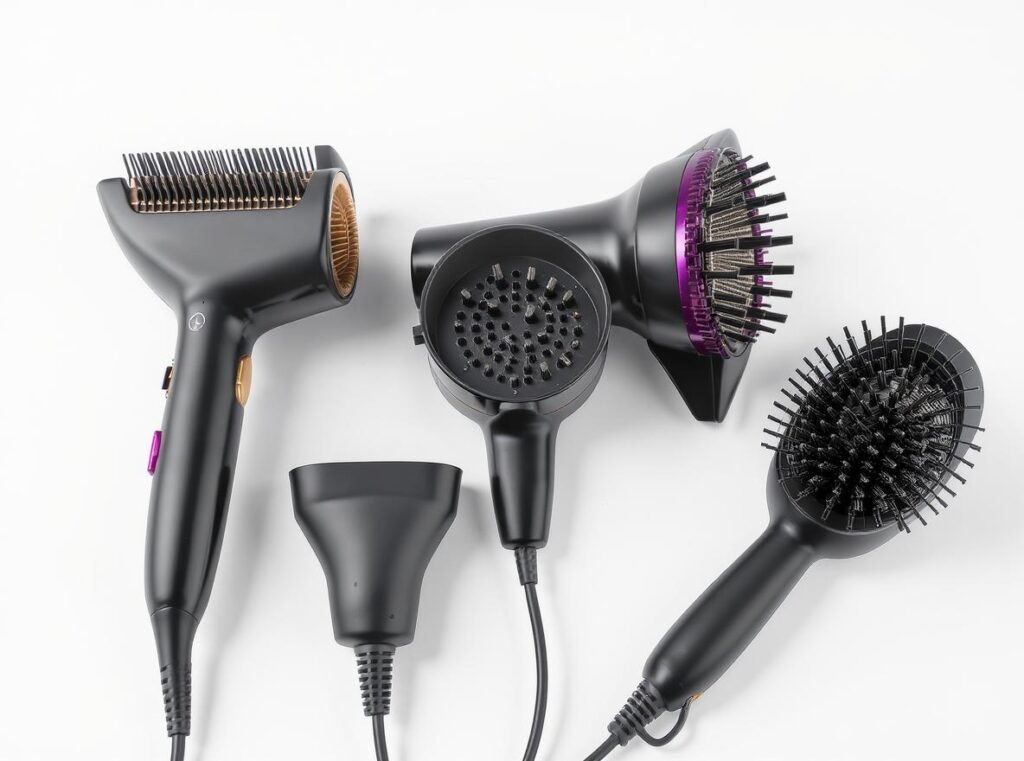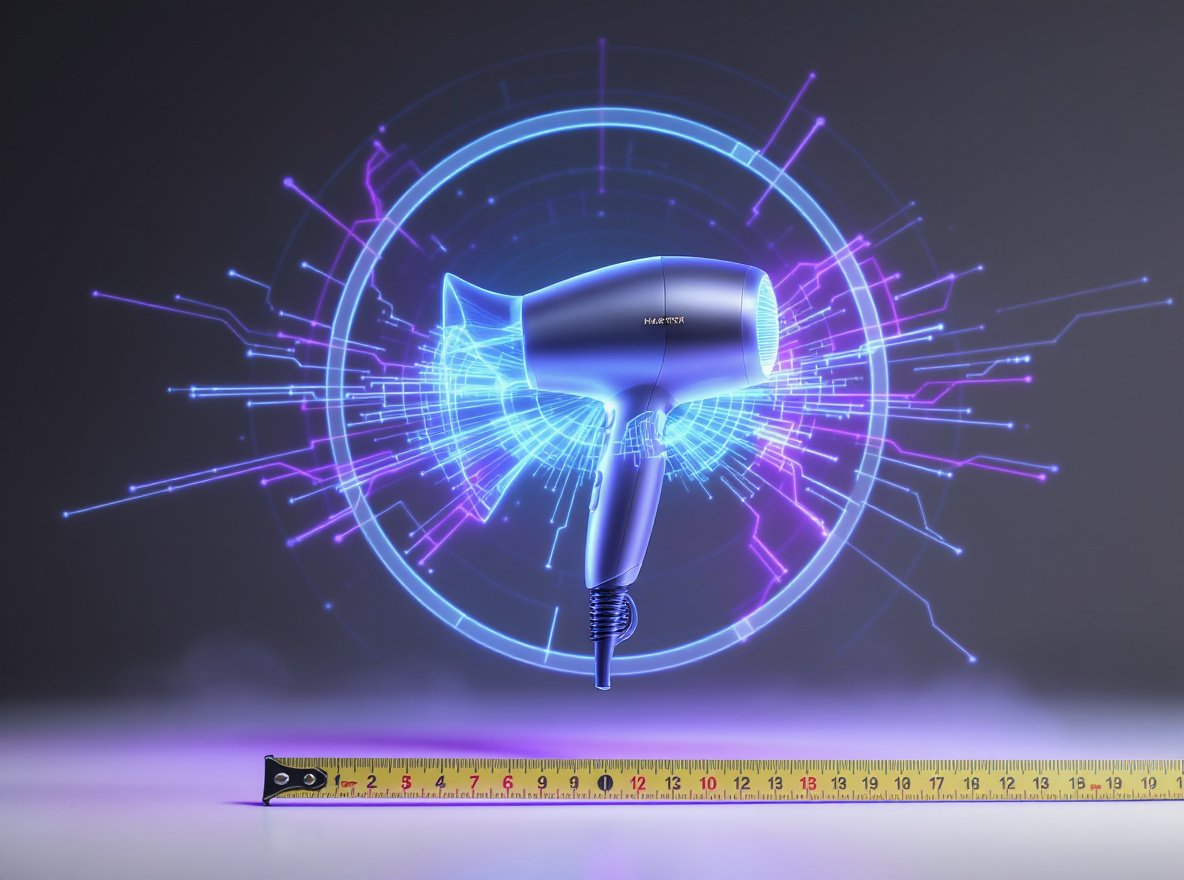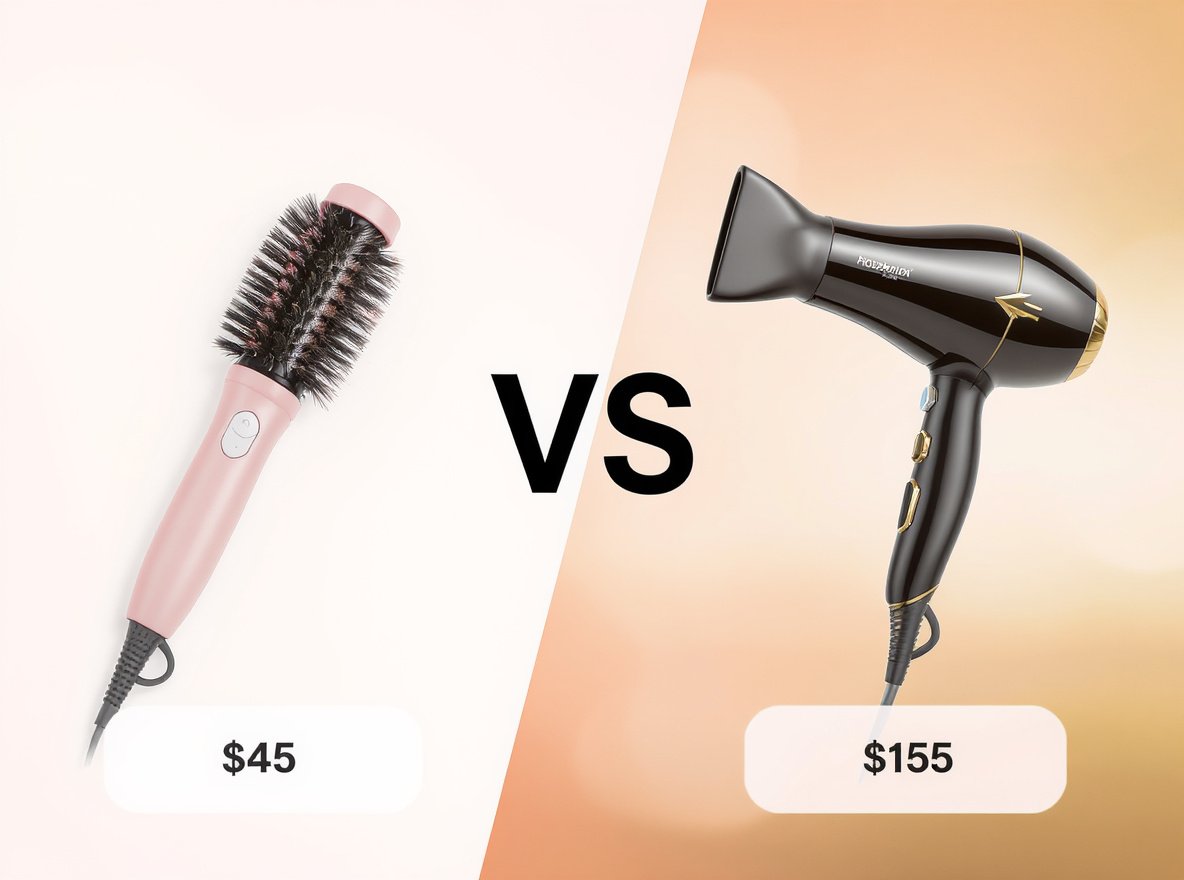Struggling with frizzy, flat, or unmanageable hair after blow-drying? You’re not alone. Many people invest in high-quality hair dryers but overlook the game-changing power of the right attachment. Using the wrong attachment can leave you with damaged, lifeless hair that takes forever to style.
The right hair dryer attachment transforms your styling routine by directing airflow precisely where your hair needs it most. Concentrator nozzles create sleek, smooth styles for straight and wavy hair, while diffusers enhance natural curls and reduce frizz. Fine hair benefits from gentle air attachments, thick hair needs wide nozzles for faster drying, and damaged hair requires heat-protecting smoothing attachments.
Ready to discover which attachment will revolutionize your hair routine? Let’s dive into the complete guide that matches your hair type with the perfect attachment.
Table of Contents
ToggleWhat Are the Main Types of Hair Dryer Attachments?
Understanding the basic attachment types helps you make informed decisions for your styling toolkit.
Modern hair dryers feature six main attachment types: concentrator nozzles for focused airflow and precise styling, diffusers with finger-like prongs for curl enhancement, pick/wide-tooth combs for detangling thick hair, flyaway attachments for sleek finishes, gentle air attachments for fine or sensitive hair, and smoothing nozzles for frizz reduction and natural-looking results.
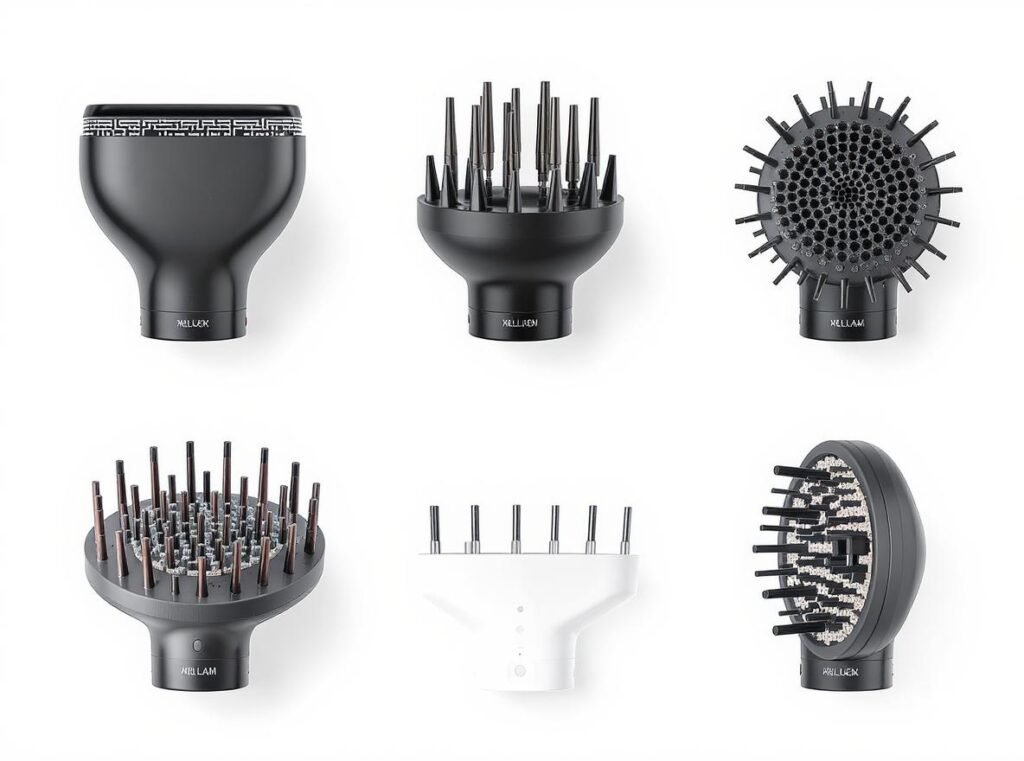
Each attachment serves a specific purpose based on hair texture, length, and desired styling outcome. Professional-grade dryers often include multiple variations of these core attachments to accommodate different techniques and hair types.
Key Attachment Functions
The science behind these attachments lies in airflow manipulation and heat distribution:
Concentrator Nozzles
- Flat, narrow design focuses airflow for precision styling
- Essential for sleek blowouts and straightening techniques
- Speeds up drying time for thick, coarse hair
Diffusers
- Wide, bowl-shaped design with finger-like prongs
- Disperses air gently to enhance curls and reduce frizz
- Preserves natural curl patterns without disruption
Pick/Wide-Tooth Comb Attachments
- Comb-like design for detangling and stretching
- Adds volume and definition to curly, thick, or textured hair
- Helps lift hair from the scalp during drying
Flyaway Attachments
- Uses controlled airflow to smooth down flyaways
- Creates ultra-sleek finishes for straight styles
- Perfect for polishing completed looks
Gentle Air Attachments
- Diffuses airflow for cooler, softer drying
- Prevents damage and color fade in fine or fragile hair
- Ideal for sensitive scalps requiring lower heat exposure
| Attachment Type | Primary Function | Best Hair Type | Key Feature |
|---|---|---|---|
| Concentrator | Precision styling | Thick, coarse hair | Flat, narrow design |
| Diffuser | Curl enhancement | Curly, wavy hair | Bowl with finger prongs |
| Pick/Comb | Detangling/Volume | Textured, thick hair | Comb-like structure |
| Flyaway | Sleek finishing | All hair types | Airflow smoothing |
| Gentle Air | Damage protection | Fine, fragile hair | Diffused, cool airflow |
| Smoothing | Frizz reduction | All lengths | Low-speed, gentle flow |
Which Attachment Works Best for Fine Hair?
Fine hair requires gentle handling to avoid damage while still achieving volume and style.
Fine hair responds best to gentle air attachments specifically designed for delicate strands and sensitive scalps. These attachments diffuse airflow to prevent damage and color fade while still drying hair quickly, making them superior to traditional concentrator nozzles that can overwhelm fine hair with excessive heat and force.
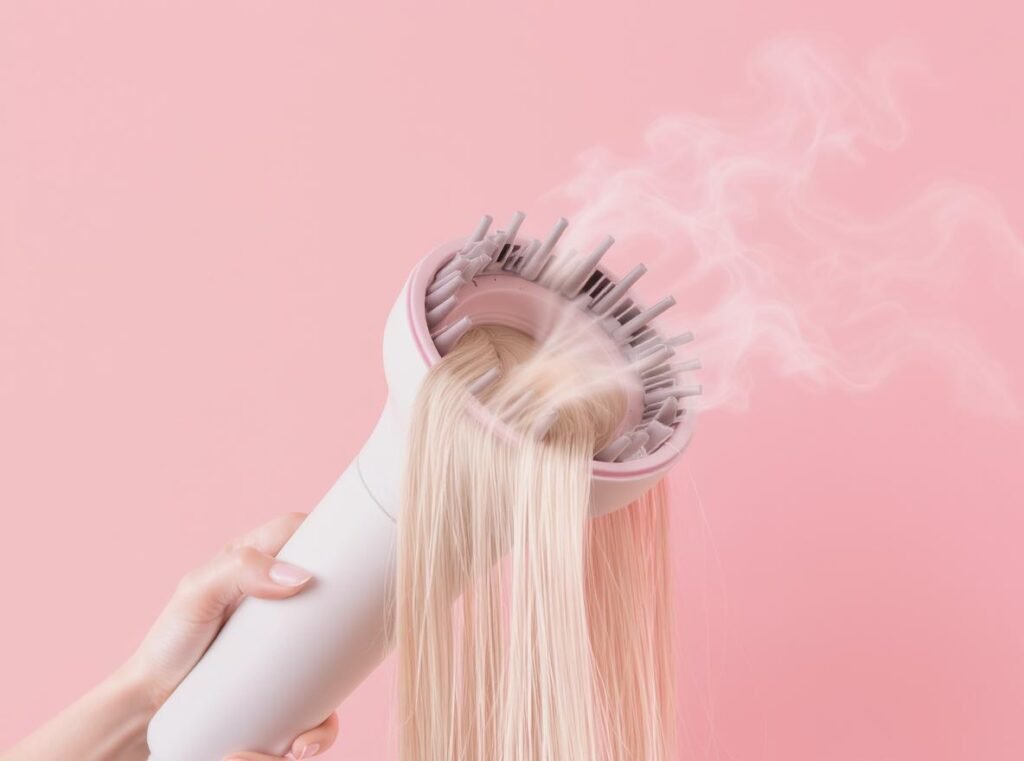
The gentle air attachment is engineered specifically for fine hair challenges, providing controlled drying without the harsh intensity that can cause breakage or make fine hair appear thinner.
Gentle Styling Techniques for Fine Hair
Fine hair styling requires specialized attachments and careful technique:
Primary Choice: Gentle Air Attachment
This attachment diffuses airflow for a cooler, softer drying experience that protects fine strands from heat damage and color fade. The dispersed air pattern prevents overwhelming delicate hair while maintaining effective drying power.
Secondary Option: Concentrator Nozzle
When using a concentrator on fine hair, choose wider openings and always use lower heat settings. The precision control allows for targeted volume creation at roots without excessive heat exposure on lengths.
Temperature management becomes critical with fine hair:
- Always start with the lowest effective heat setting
- Use cool shots frequently to prevent overheating
- Keep the dryer moving to avoid concentrated heat exposure
- Consider air-drying to 50% before using any heated attachment
Essential fine hair attachment features:
- Diffused airflow patterns that spread heat evenly
- Multiple speed and temperature controls
- Cool shot functionality for setting styles
- Lightweight construction to prevent styling fatigue
| Fine Hair Challenge | Best Attachment | Technique | Expected Result |
|---|---|---|---|
| Heat sensitivity | Gentle air attachment | Low heat, constant motion | Protected, healthy hair |
| Lack of volume | Concentrator (wide) | Root lifting technique | Natural body and lift |
| Color preservation | Gentle air attachment | Cool air finishing | Maintained color vibrancy |
What’s the Best Attachment for Thick, Coarse Hair?
Thick hair demands powerful airflow and strategic heat distribution to achieve efficient drying and styling.
Thick, coarse hair requires concentrator nozzles as the essential attachment for effective styling. These flat, narrow attachments direct strong, focused airflow to speed up drying time and tame unruly strands, making them indispensable for managing dense hair textures that standard attachments cannot handle efficiently.
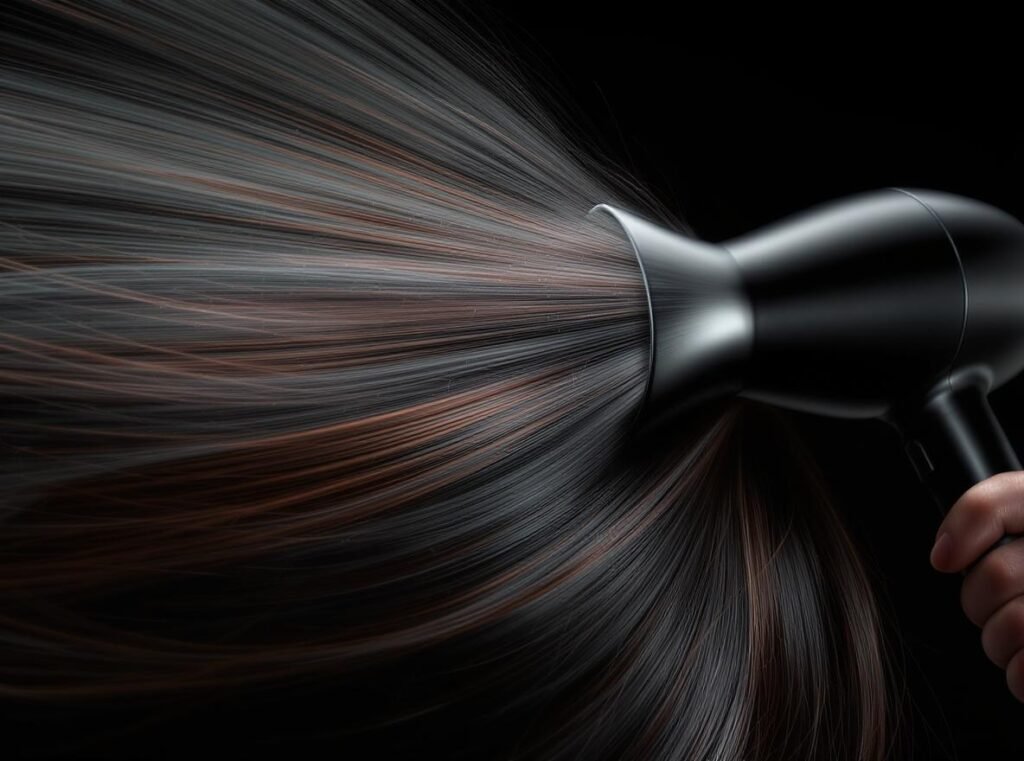
High-wattage dryers paired with concentrator nozzles provide the power needed to penetrate multiple hair layers and achieve faster, more effective results on thick hair.
Power Styling for Dense Hair
Thick hair requires a dual-attachment approach for optimal results:
Primary Tool: Concentrator Nozzle
The flat, narrow design creates focused airflow that penetrates dense hair layers effectively. This concentrated power reduces drying time significantly compared to standard attachments.
Secondary Tool: Pick/Wide-Tooth Comb Attachment
This specialized attachment helps detangle and stretch thick, curly, or coily hair while adding volume and definition. The comb-like structure works through dense textures that other attachments struggle to manage.
Professional technique for thick hair management:
Start with the pick attachment to detangle and lift hair from the scalp. Work in 2-inch sections, using the comb to stretch and separate strands. This preparation allows the concentrator nozzle to work more effectively in the second phase.
Switch to the concentrator nozzle for focused drying and smoothing. Use high heat initially for moisture removal, then medium heat for styling control. The narrow opening ensures powerful airflow reaches inner hair layers.
Thick hair attachment strategy:
- Begin with highest appropriate heat setting for efficiency
- Use pick attachment for initial detangling and volume
- Switch to concentrator for precision styling and smoothing
- Finish with cool shots to lock in results and add shine
The combination approach addresses both the volume and smoothness needs of thick hair, ensuring complete styling control from roots to ends.
How Should I Use a Diffuser for Curly Hair?
Curly hair requires specialized techniques to enhance natural patterns while minimizing frizz and damage.
Diffusers work by dispersing airflow through finger-like prongs and a wide bowl design, allowing curly hair to dry in its natural pattern without disruption. The proper technique involves sectioning hair and gently placing each section into the diffuser bowl, using it like your hand to softly scrunch curls from ends upward while moving around your head in small sections.
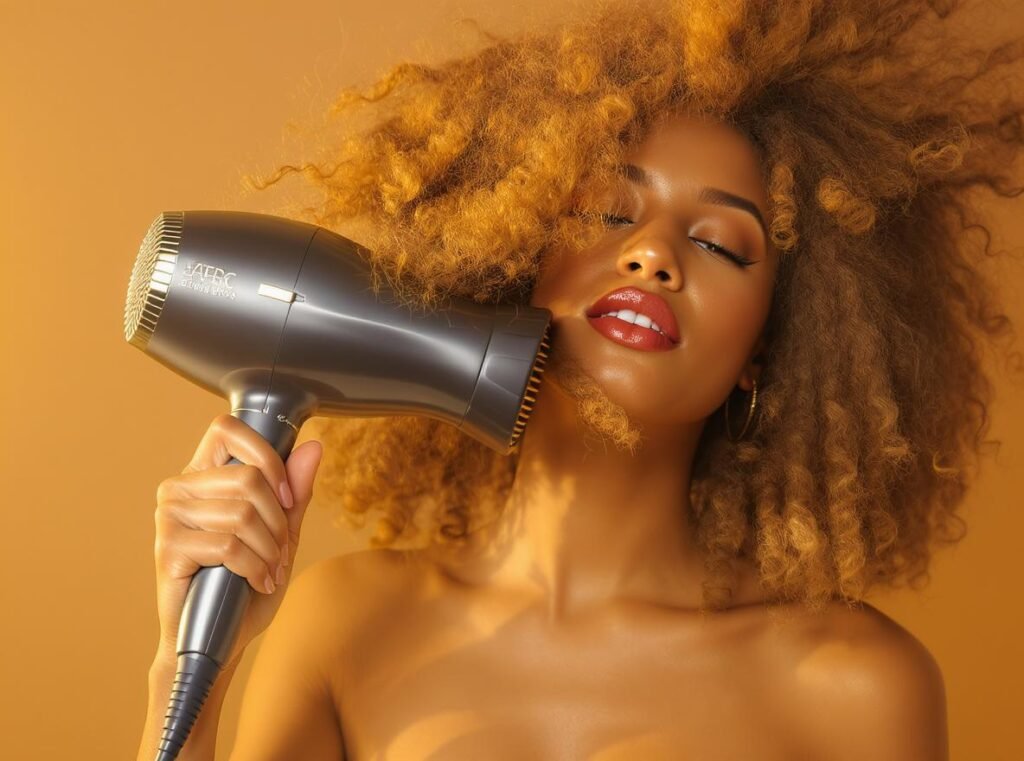
The key to diffuser success lies in the scrunching motion and sectional approach that preserves curl formation while providing even heat distribution.
Mastering Diffuser Techniques
Professional diffuser technique transforms curly hair from undefined to beautifully enhanced:
Step-by-Step Diffusing Process
- Preparation: Apply leave-in conditioner and curl-enhancing products to damp (not soaking) hair
- Sectioning: Divide hair into manageable sections for even drying
- Placement: Gently place each section into the diffuser bowl
- Motion: Use the diffuser as if it were your hand, softly scrunching curls from ends upward
- Movement: Work around your head in small sections, spending a few seconds on each area
- Root Focus: Move up toward the roots as you progress through each section
Volume Enhancement Technique
For added volume, dry your hair upside down, focusing on the roots first. This gravity-defying position allows curls to lift away from the scalp naturally.
Heat and Speed Settings
Start with the lowest heat setting and medium airflow to prevent curl disruption. High heat can break curl patterns and create unwanted frizz, while gentle heat preserves natural formation.
Professional diffusing tips:
- Hold the diffuser stationary for 10-15 seconds per section
- Avoid moving the diffuser through hair (this causes frizz)
- Use a “press and lift” motion rather than circular movements
- Allow curls to cool in the diffuser bowl before moving to the next section
Diffuser Selection Guide
Different curl types benefit from specific diffuser designs:
| Curl Type | Diffuser Style | Prong Length | Best For |
|---|---|---|---|
| Loose waves (2A-2B) | Shallow bowl | Short prongs | Volume at roots |
| Defined curls (3A-3B) | Medium bowl | Medium prongs | Curl definition |
| Tight curls (3C-4A) | Deep bowl | Long prongs | Frizz reduction |
Which Attachment Creates the Smoothest Blowout?
Achieving salon-quality smoothness at home depends on selecting the right attachment and technique combination.
Concentrator nozzles create the smoothest blowouts by directing focused, precise airflow down the hair shaft, sealing cuticles flat for ultimate sleekness. For finishing touches, flyaway attachments use controlled airflow to smooth down any remaining flyaways and polish the look for ultra-sleek, professional results.
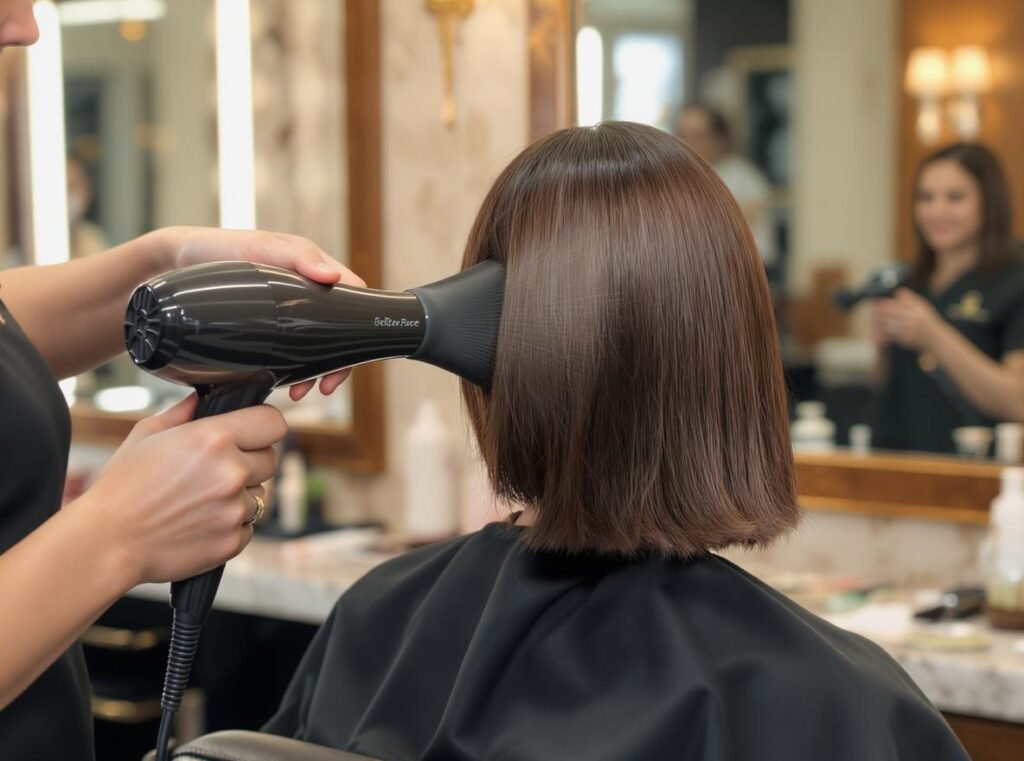
The combination of concentrator precision and flyaway finishing creates salon-quality smoothness that rivals professional styling.
Professional Blowout Techniques
Creating salon-quality smoothness requires systematic attachment use and proper technique:
Primary Styling: Concentrator Nozzle
The flat, narrow design provides precise, directed airflow essential for straightening and smoothing hair. This attachment is the foundation of any professional blowout.
Finishing Touch: Flyaway Attachment
After completing the main blowout with the concentrator, switch to the flyaway attachment to smooth down any remaining flyaways and create an ultra-polished finish.
Section Strategy
Divide hair into horizontal sections no thicker than the width of your round brush. Smaller sections ensure better heat penetration and more controlled smoothing results.
Airflow Direction
Always direct the concentrator nozzle from roots to ends, following your brush movement. This technique aligns cuticles uniformly, creating the light reflection that appears as professional shine.
Heat Management
Use medium-high heat for initial moisture removal, then switch to medium heat for styling precision. Complete each section with a cool shot while maintaining tension to lock in smoothness.
Professional blowout sequence:
- Start with back sections, working systematically toward the front
- Use coordinated downward brush strokes with matching airflow direction
- Maintain consistent tension throughout each stroke for even results
- Switch to flyaway attachment for final smoothing and polish
- Seal entire style with cool air for lasting hold
Brush pairing recommendations:
- Round brushes for volume and curl
- Vented brushes for faster drying
- Paddle brushes for maximum smoothness on long hair
Can I Use Multiple Attachments During One Styling Session?
Strategic attachment switching can optimize results for complex styling goals and mixed hair textures.
Using multiple attachments during one styling session is not only possible but often recommended for achieving professional-quality results. You can start with a diffuser to dry curls, then switch to a concentrator or flyaway attachment for smoothing or finishing touches, allowing you to customize your style and address different needs throughout the styling process.
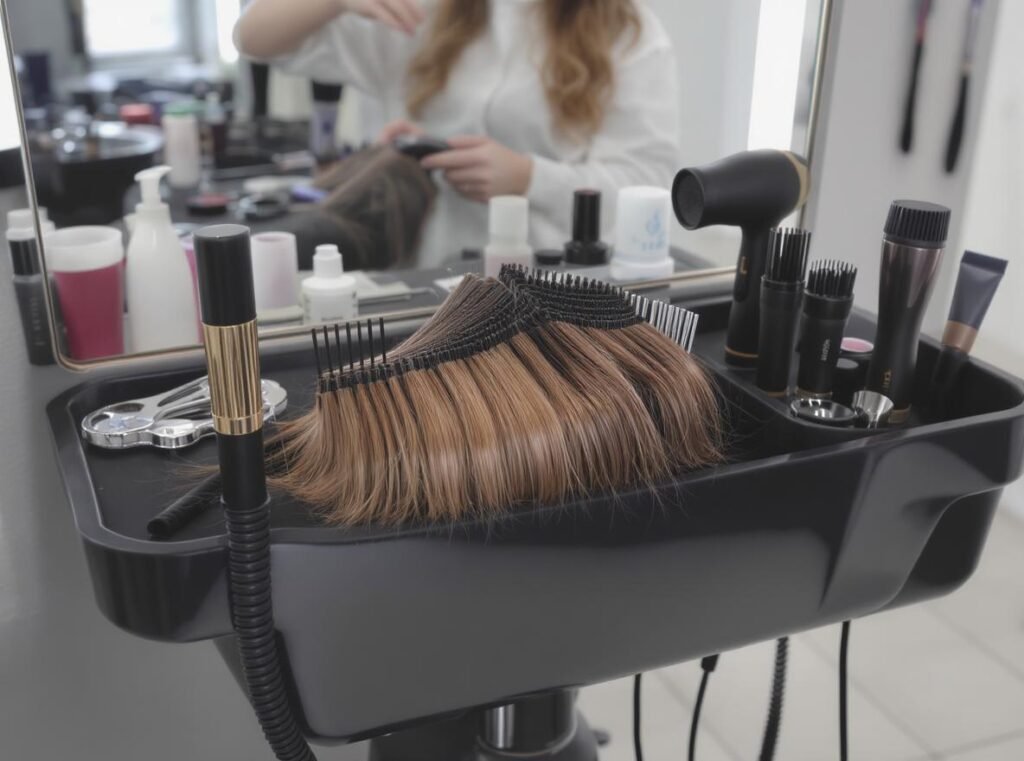
This flexible approach maximizes each attachment’s strengths while accommodating complex styling goals and mixed hair textures.
Multi-Attachment Styling Strategy
Complex styles benefit from targeted attachment use:
Layered Hair Approach
Different hair layers may require different treatments. Use a wide concentrator for the underlying layers to create volume and body, then switch to a narrow concentrator for surface layers that need precision smoothing.
Mixed Texture Management
If you have naturally straight roots with wavy or curly mid-lengths and ends, start with a concentrator at the roots for volume, then switch to a diffuser for the textured sections.
Timing considerations for attachment switching:
- Allow hair to reach 70-80% dryness before switching attachments
- Clean attachments between uses to prevent product buildup
- Adjust heat settings when changing attachments to match their intended use
- Use cool shots between attachment changes to prevent overheating
| Styling Goal | Primary Attachment | Secondary Attachment | Finishing Touch |
|---|---|---|---|
| Volume + Smoothness | Wide concentrator | Narrow concentrator | Cool shot |
| Defined curls + Face framing | Diffuser | Narrow concentrator | Smoothing attachment |
| Textured waves + Sleek roots | Concentrator (roots) | Diffuser (lengths) | Cool shot |
What Attachment Should I Use for Damaged or Chemically Treated Hair?
Damaged hair requires gentle handling with specialized attachments designed for heat protection and moisture retention.
Damaged or chemically treated hair benefits most from gentle air attachments that provide cooler, diffused airflow to minimize heat exposure and prevent further damage or color fade. These specialized attachments are designed specifically for fragile hair, offering protection while still providing effective drying results.
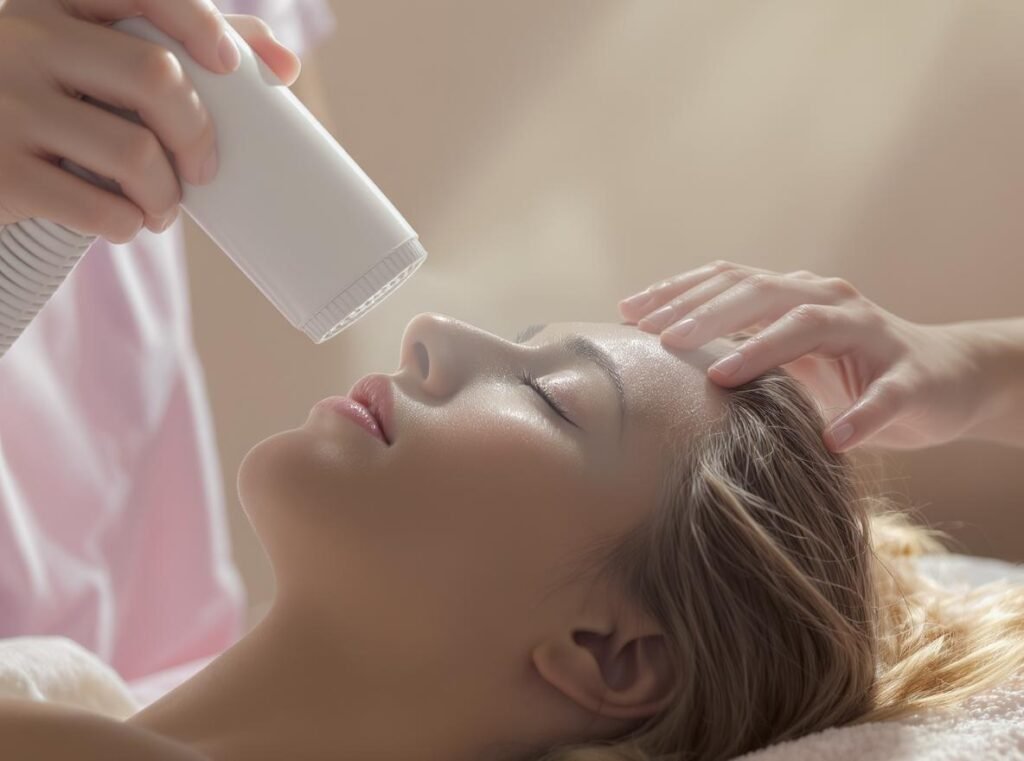
Avoid direct, high-velocity airflow that can worsen existing damage in chemically treated or compromised hair structures.
Protective Styling for Compromised Hair
Damaged hair requires specialized attachment selection and modified techniques:
Primary Choice: Gentle Air Attachment
This attachment provides cooler, diffused airflow specifically engineered for fragile hair types. The dispersed air pattern reduces direct heat contact while maintaining drying effectiveness.
Temperature Guidelines
Always use the lowest effective heat setting with damaged hair. Compromised protein structures cannot withstand high temperatures without experiencing further deterioration.
Protective Styling Protocol
- Heat Protection: Apply thermal protectant products before any heat exposure
- Low Heat Settings: Use the gentlest temperature that still provides results
- Limited Frequency: Restrict heat styling to 2-3 times per week maximum
- Cool Finishing: Use cool shots frequently throughout the styling process
- Moisture Preservation: Leave hair slightly damp rather than completely dry
Gentle Air Attachment Benefits for Damaged Hair:
- Prevents color fade in chemically treated hair
- Reduces further cuticle damage
- Maintains essential moisture levels
- Minimizes heat-related protein damage
- Protects sensitive scalp conditions
Recovery-focused styling approach:
- Prioritize hair health over styling speed
- Use lower heat settings even if drying takes longer
- Incorporate nourishing treatments between styling sessions
- Monitor hair condition and adjust technique accordingly
| Damage Type | Recommended Attachment | Heat Setting | Special Considerations |
|---|---|---|---|
| Color-treated | Gentle air | Low | Prevents color fade |
| Chemically relaxed | Gentle air | Very low | Maintains moisture |
| Heat damaged | Gentle air | Cool/low | Prevents further damage |
| Bleached hair | Gentle air | Low | Protects fragile structure |
How Do I Choose Attachments for Professional Salon Results?
Achieving salon-quality results at home requires understanding professional techniques and tool selection.
Professional results require matching the right attachment to your specific hair type and desired style outcome. Use concentrator nozzles for sleek, polished blowouts; diffusers for defined curls or waves; pick/wide-tooth combs for volume and detangling thick or curly hair; flyaway attachments for smooth, shiny finishes; and gentle air attachments for fine or damaged hair with lower heat requirements.
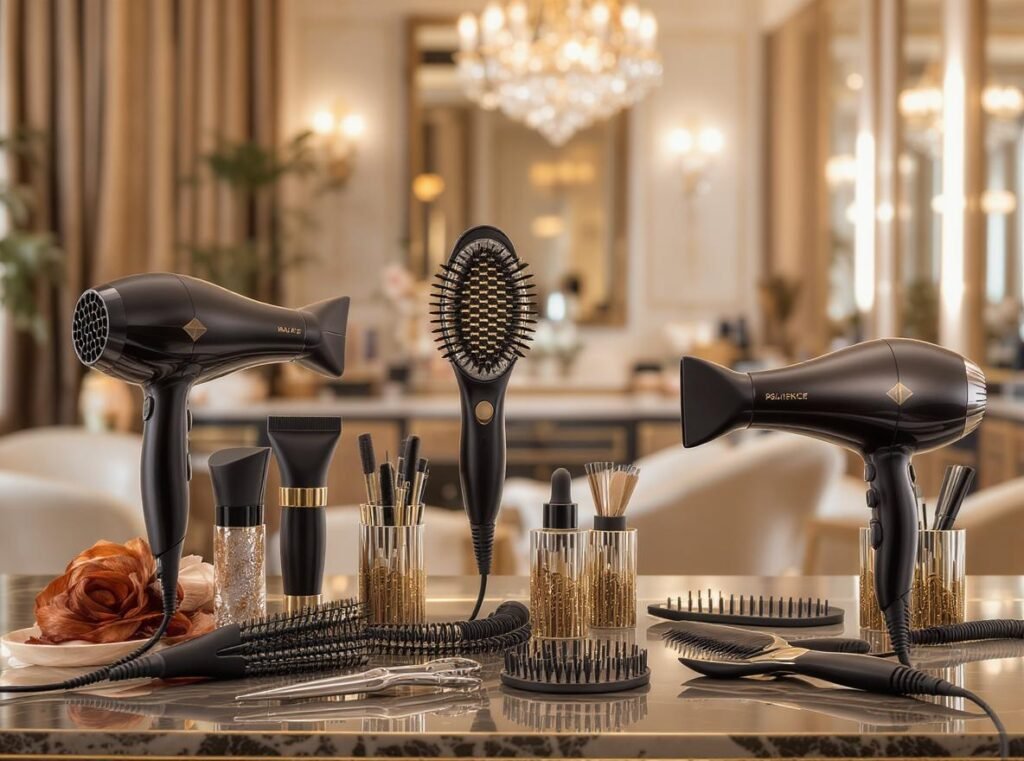
Pair these attachments with professional brushes (round, vented, or paddle) and appropriate styling products for salon-quality results at home.
Professional Attachment Standards
Quality attachments share common characteristics that distinguish them from basic versions:
Material Quality
Professional attachments use heat-resistant materials that maintain shape and function under high temperatures. Ceramic and tourmaline components add negative ion generation for smoother results.
Magnetic Attachment Systems
Secure, easy-to-change attachment systems allow quick switching during styling sessions. Magnetic systems provide better stability than simple slip-on designs.
Precision Engineering
Exact nozzle dimensions and airflow patterns create predictable results. Professional attachments maintain consistent performance across multiple uses.
Investment considerations for professional-quality attachments:
- Compatibility with your specific dryer model
- Heat resistance ratings for high-temperature use
- Warranty coverage for professional-grade usage
- Replacement part availability for long-term use
| Hair Type/Goal | Primary Attachment | Secondary Attachment | Professional Brush Pairing |
|---|---|---|---|
| Fine Hair | Gentle Air | Concentrator (wide) | Round brush for volume |
| Thick/Coarse Hair | Concentrator | Pick/Wide-Tooth Comb | Vented brush for speed |
| Curly Hair | Diffuser | N/A | Denman brush for definition |
| Smoothest Blowout | Concentrator | Flyaway | Paddle brush for sleekness |
| Damaged/Chemically Treated | Gentle Air | N/A | Wide-tooth comb (minimal heat) |
| Professional Versatility | Match to hair type | Flyaway for finishing | Multiple brush types |
Summary
Choosing the right hair dryer attachment transforms your styling routine from frustrating to fantastic. Concentrator nozzles excel for smooth, sleek styles on straight and wavy hair, while diffusers enhance natural curls without frizz. Fine hair needs gentle, wide attachments, thick hair requires focused, narrow nozzles, and damaged hair benefits from heat-dispersing designs. Professional results come from understanding your hair type and matching it with the appropriate attachment technique.
Ready to upgrade your hair styling game? Explore our professional-grade Conason P1C High-Speed Hair Dryer that includes multiple precision attachments for every hair type. For wholesale opportunities and bulk orders, browse our complete hair dryer collection and contact us for competitive pricing on professional-quality styling tools that your customers will love.

